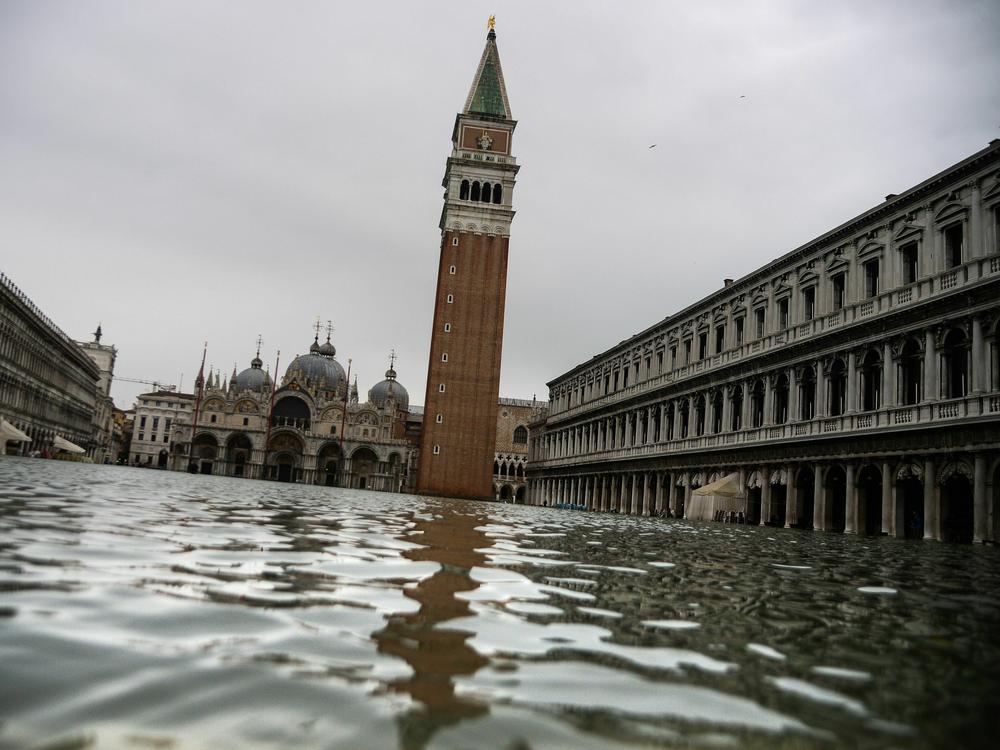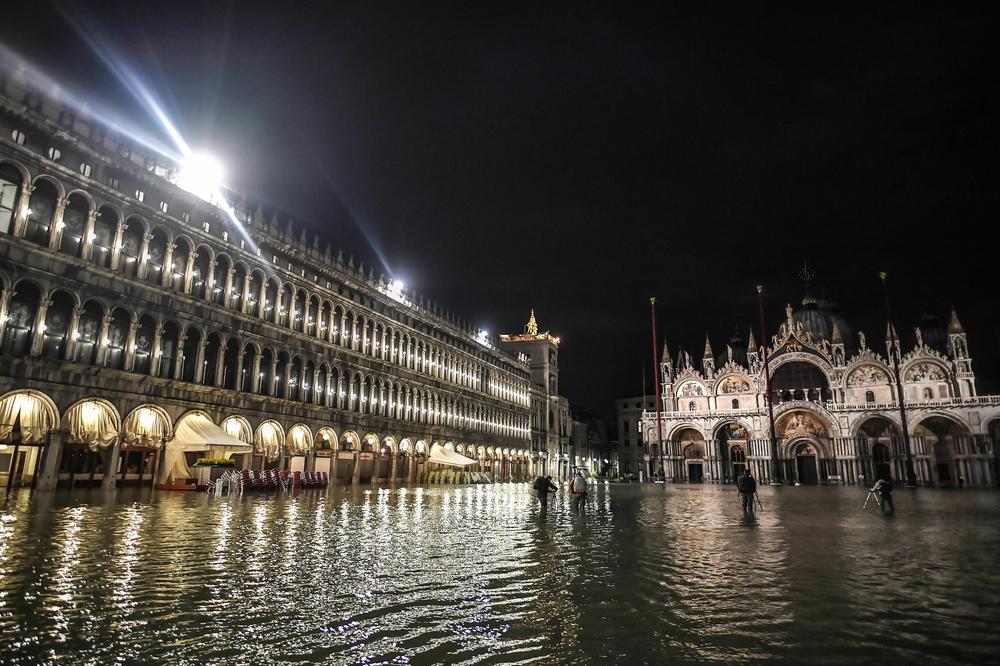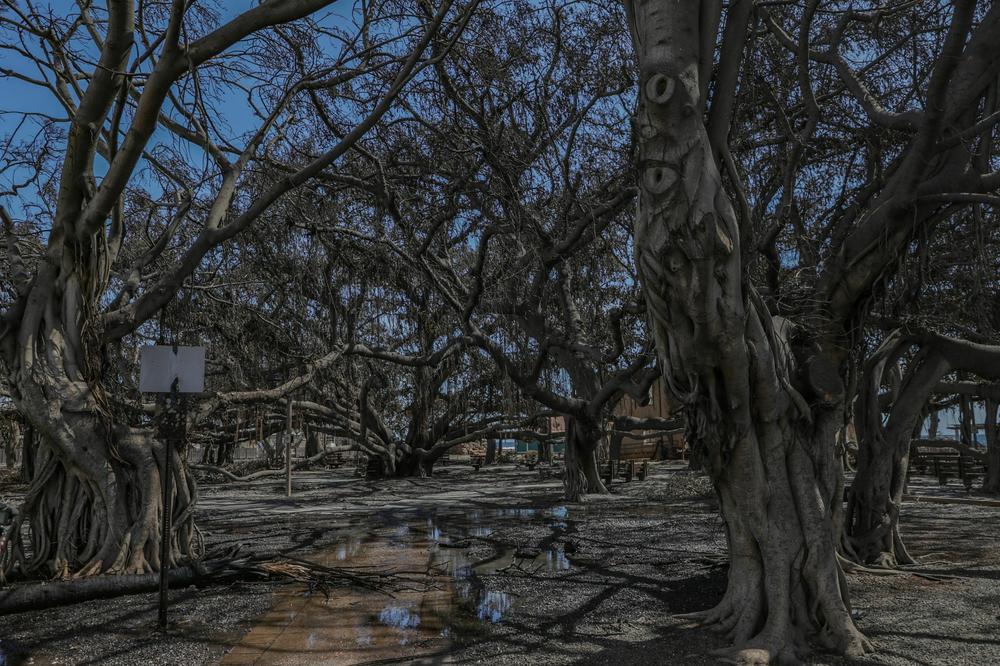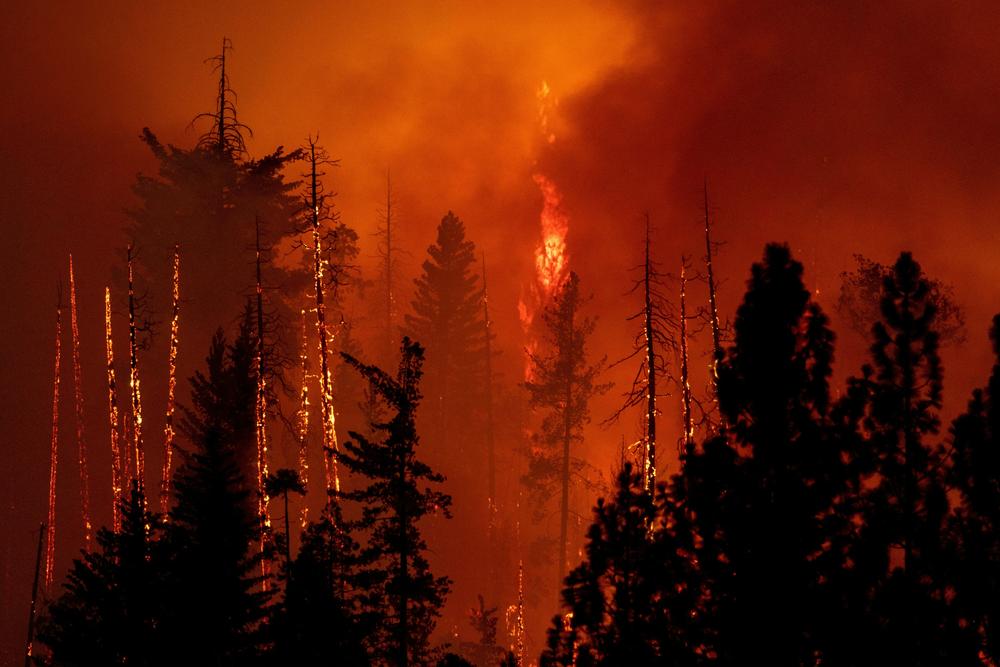Section Branding
Header Content
Venice may be put on the endangered list, thanks to human-created climate change
Primary Content
Venice is known for its maze-like canals, Renaissance buildings and gondola rides. But what makes this picturesque city so famous is under threat due to human-caused climate change.
World leaders associated with UNESCO, a branch of the United Nations that helps to protect heritage sites around the world, are meeting this month in Riyadh, Saudi Arabia to discuss whether to add the Italian city to a list of endangered world heritage sites.
A UNESCO report says that along with over-tourism and construction, climate change-induced sea level rise and extreme weather have put Venice's storied old buildings and landscapes at risk.
In November 2019, floods endangered historical treasures and buildings. And earlier this year, the city suffered from an opposite problem when severe drought made it impossible for the gondolas to pass through some of the city's canals.
Italian authorities have taken some steps to protect Venice's treasures, such as installing temporary barriers to protect the Saint Mark's Basilica and nearby buildings from sea level rise. But UNESCO says Italian authorities haven't done enough to address these issues.
"The combined effects of human induced and natural changes (due to sea level rise, extreme weather events and other climate change induced phenomena) are causing deterioration and damage to build structures and urban areas, and threaten the integrity of the cultural, environmental and landscape attributes and values of the property," UNESCO wrote in its report recommending Venice be designated as endangered. "Many of these issues, which individually represent threats to the OUV [Outstanding Universal Value – the basis for any nomination to the world heritage sites list] of the property, but which also have a cumulative adverse impact, remain unresolved or only temporarily addressed."
So what is 'cultural heritage'?
Cultural heritage isn't something that often makes climate change headlines.
In fact, the relationship between the two isn't something that was much discussed until about a decade or so ago, in part because conversations about climate change have focused on the science and the impacts.
"I don't see the amount of greenhouse gasses in the atmosphere when I walk out the door in the morning," said Isabel Rivera-Collazo, an environmental archaeologist at the University of California, San Diego, who studies how people adapt to climate change. "It doesn't make sense to our brains because we don't engage with climate, we engage with weather."
But the level of attention the media has paid to the destruction of historic sites on Maui in the recent wildfires, and the ongoing discussions around UNESCO's bid to include Venice to its list of endangered world heritage sites, suggests human-created climate change and cultural heritage might have more to do with each other than previously thought.
Rivera-Collazo said when cataclysmic weather occurs with greater intensity and frequency from warmer temperatures brought on by the burning of fossil fuels, climate change starts to feel tangible to people.
"We are seeing the abnormal fires; we are seeing the super impactful floods," said Rivera-Collazo. "So now things are making sense because we are experiencing them."
Another reason it's taken a while for cultural heritage to figure in climate change conversations is because of a limited understanding of what cultural heritage is – and why it even matters when so many more serious losses to lives, homes and livelihoods occur as climate change-related disasters hit.
"Most people understand cultural heritage to be archeological sites, historic buildings, museums, and also artifacts that might be in museums, things that you find in archeological digs," said Adam Markham, deputy director for climate and energy at the Union of Concerned Scientists, and a leader in the field of climate change and cultural heritage. "But it's so much more than that."
Markham said cultural heritage also encompasses ways of life.
"That might be different foods that people eat, the cosmologies or beliefs that they have, and the seasonal festivals that they organize," Markham said. "So it's things that people do in their communities that have been passed on from generation to generation. These things can't be put in a museum. They're a part of people's lives."
Suzanne Davis, president of the American Institute for Conservation, said people don't have to live in or around a world heritage site or national historical landmark to care about cultural heritage. "It exists in every community," Davis said. "Most people have things and places in their lives that they really care about. And climate change is affecting those things and those places no matter where you live."
A sense of place
So when climate change-related disasters happen, it's not just physical places that are lost, but also people's connection to those places.
After the recent fires on Maui, for example, some media articles focused on how badly the fire scorched a famous 150-year-old banyan tree in downtown Lahaina. What wasn't covered as much was what the enormous tree meant for the local community.
"That's where everyone goes," said Darryl Fujiwara, the organizer of the Emma Farden Sharpe Hula Festival. The annual event usually happens under the banyan tree's massive canopy, but moved online this summer owing to the fire. "It's kind of like a town square for us."
Southern Sierra Miwuk Nation tribal council member Tara Fouch-Moore explained the attachment between cultural heritage and place this way:
"If you took a really old castle, and you put it somewhere else, like in the desert, it would completely lose its context," Fouch-Moore said. "It would lose its stories. It would lose the connection of the people whose families have grown up there. And so that is the exact same thing with all of our heritage items."
Fouch-Moore's tribe has struggled with displacement and destruction of its sacred sites ever since white settlers pushed it and other indigenous communities out of their traditional homelands in the Yosemite Valley starting in the 1850s. More recently, the Southern Sierra Miwuk has been ravaged by ever-worsening wildfires. Fouch-Moore said the Oak Fire of 2022 displaced 127 households and destroyed ancient indigenous heritage sites, as well as many species of flora and fauna the tribe traditionally uses in cooking, medicine and art.
The tribe is now collaborating with county and federal agencies to restore and protect its indigenous heritage. One project involves restoring a local watershed that runs through the tribe's current homebase of Mariposa, California, so indigenous plants and practices can thrive again having been decimated by wildfires, floods and invasive species. The community is also building Wahhoga, a cultural center that occupies a site where an ancient Indian village once stood in the heart of Yosemite.
"You have to be on the land to learn to live on the land," said Fouch-Moore.
It can't all be saved
Restoring healthy waterways and forests helps to manage the impacts of climate change. Yet fires and floods keep coming, whether the land is protected or not. And cultural heritage in all its forms is perpetually at risk.
"Storm surges do not care if it's a National Park or a parking lot," said Marcy Rockman, who coordinated the National Park Service's climate change adaptation efforts for seven years before becoming an independent researcher and consultant in the climate change and cultural heritage space. "It will flood both of them equally if they're in the path."
Rockman said communities face tough decisions about what parts of their cultural heritage to hold on to – and what to let go of – in preparation for future climate change-related events. She said that's why it's vital for authorities to engage residents in the decision-making process to learn what cultural heritage is most valued.
That's because what matters cultural heritage-wise to residents in a particular neighborhood may not necessarily be the most obvious landmarks.
"Places that do not have plaques on the buildings also have history and heritage, and where heritage is often most vital is where it is lived and used," Rockman said. "We cannot hold back the sea. But we can carry forward some of what's important about this place. What would you like that to be?"
Copyright 2023 NPR. To see more, visit https://www.npr.org.





